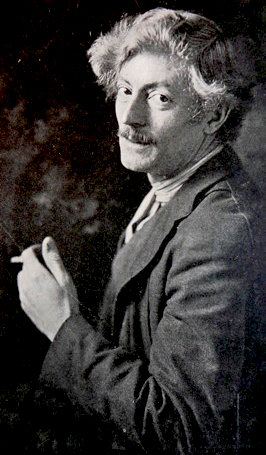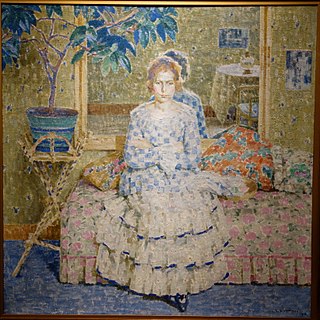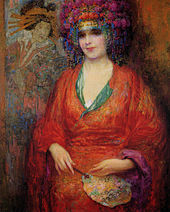
Impressionism was a 19th-century art movement characterized by relatively small, thin, yet visible brush strokes, open composition, emphasis on accurate depiction of light in its changing qualities, ordinary subject matter, unusual visual angles, and inclusion of movement as a crucial element of human perception and experience. Impressionism originated with a group of Paris-based artists whose independent exhibitions brought them to prominence during the 1870s and 1880s.

American Impressionism was a style of painting related to European Impressionism and practiced by American artists in the United States from the mid-nineteenth century through the beginning of the twentieth. The style is characterized by loose brushwork and vivid colors with a wide array of subject matters but focusing on landscapes and upper-class domestic life.

Giverny is a commune in the northern French department of Eure. The village is located on the "right bank" of the river Seine at its confluence with the river Epte. It lies 80 km (50 mi) west-northwest of Paris, in the region of Normandy. It is best known as the location of Claude Monet's garden and home.
Karl Albert Buehr (1866–1952) was a painter born in Germany.

Frederick Carl Frieseke was an American Impressionist painter who spent most of his life as an expatriate in France. An influential member of the Giverny art colony, his paintings often concentrated on various effects of dappled sunlight.

Theodore Robinson was an American painter best known for his Impressionist landscapes. He was one of the first American artists to take up Impressionism in the late 1880s, visiting Giverny and developing a close friendship with Claude Monet. Several of his works are considered masterpieces of American Impressionism.

Alson Skinner Clark was an American Impressionist painter best remembered for his landscapes. He was also a photographer, plein aire painter, art educator and muralist.

Soren Emil Carlsen was an American Impressionist painter who emigrated to the United States from Denmark. He became known for his still lifes. Later in his career, Carlsen expanded his range of subjects to include landscapes and seascapes as well.

Theodore Nikolai Lukits was a Romanian American portrait and landscape painter. His initial fame came from his portraits of glamorous actresses of the silent film era, but since his death, his Asian-inspired works, figures drawn from Hispanic California and pastel landscapes have received greater attention.
Arny Karl was one of the key artists in the early stages of the California Plein-Air Revival, which started in the 1980s and continues to this day. Along with Tim Solliday and Peter Seitz Adams, Karl helped revitalize the use of pastels to paint outdoors or en plein air, as the French described regarding the practice of working directly from nature. Karl was a student of Theodore Lukits (1897–1992), who was a prominent California Impressionist and the best known Early California painter to have worked in pastel. His work has been included in a number of museum exhibitions, is represented in a number of prominent public and private collections and has been the subject of a number of curatorial essays.
Peter Seitz Adams is an American artist. His body of work focuses on landscapes and seascapes created en plein air in oil or pastel as well as enigmatic figure and still-life paintings. He is noted for his colorful, high-key palette and broad brushwork. Adams has held numerous solo and group exhibitions in galleries and museums, including throughout California, the Western United States, and on the East Coast in Philadelphia, Vermont, and New York. Adams is the longest serving President of the California Art Club and has served on its board of directors in Pasadena, California from 1993 to 2018. He is also a writer on subjects relating to historic artists for the California Art Club Newsletter, as well as for a number of the organization's exhibition catalogs.

The terms California Impressionism and California Plein-Air Painting describe the large movement of 20th century California artists who worked out of doors, directly from nature in California, United States. Their work became popular in the San Francisco Bay Area and Southern California in the first three decades after the turn of the 20th century. Considered to be a regional variation on American Impressionism, the California Impressionists are a subset of the California Plein-Air School.

Christian von Schneidau (1893–1976) was a well known California portrait painter who was recognized for his paintings of Hollywood stars and the Los Angeles elite. During the Roaring Twenties he painted Mary Pickford and other figures from the film industry as well as a number of outdoor figures done in the classic American Impressionist manner. Von Schneideau was born in Ljungby, Kalmar County, Sweden 1893, with the name Bror Christian Valdemar Von Schneidau, but went by the shortened Christian von Schneidau. In addition to his portraiture, von Schneidau was also a landscape painter and a private teacher who passed on the French principles of instruction, which he learned at the Art Institute of Chicago to his students. Von Schneidau was also the founder of the Scandinavian-American Art Society in 1938 and served as its president for many years. He was also an active member of the California Art Club.
Tim Solliday is a contemporary California Plein-Air Painter and Western Artist who is known for his San Gabriel Valley landscapes and his paintings of American Indians and other western subjects. He studied with the California Impressionist portrait and landscape painter Theodore Lukits (1897–1992) in the 1970s and began working professionally in the early 1980s. Solliday is described as a painter with a "muscular, masculine style" and has been compared to artists of the Taos Ten, especially E. Martin Hennings. He is a Signature Member of the California Art Club. He exhibits with the Laguna Plein-Air Painters Association, the Oil Painters of America and at the Maynard Dixon Invitational, which is held in Utah each year. Solliday's work has been featured in a number of American art magazines such as Southwest Art, American Artist and Art of the West. Through his plein-air work in the pastel medium and large canvasses, he has played an important role in the revival of landscape painting in Southern California.
Tonal Impressionism was an artistic style of "mood" paintings with simplified compositions, done in a limited range of colors, as with Tonalist works, but using the brighter, more chromatic palette of Impressionism. An exhibition titled "Tonal Impressionism" was curated by the art historian Harry Muir Kurtzworth for the Los Angeles Art Association Gallery at the Los Angeles Central Library in June 1937 with the works of a number of prominent California artists. In recent years, the term has also been used to describe a non-linear approach to painting where the subject is massed in with tonal values without the use of underdrawing.
California Tonalism was art movement that existed in California from circa 1890 to 1920. Tonalist are usually intimate works, painted with a limited palette. Tonalist paintings are softly expressive, suggestive rather than detailed, often depicting the landscape at twilight or evening, when there is an absence of contrast. Tonalist paintings could also be figurative, but in them, the figure was usually out of doors or in an interior in a low-key setting with little detail.

Richard E. Miller was an American Impressionist painter and a member of the Giverny Colony of American Impressionists. Miller was primarily a figurative painter, known for his paintings of women posing languidly in interiors or outdoor settings. Miller grew up in St. Louis, studied in Paris, and then settled in Giverny. Upon his return to America, he settled briefly in Pasadena, California and then in the art colony of Provincetown, Massachusetts, where he remained for the rest of his life. Miller was a member of the National Academy of Design in New York and an award-winning painter in his era, honored in both France and Italy, and a winner of France's Legion of Honor. Over the past several decades, he has been the subject of a retrospective exhibition and his work has been reproduced extensively in exhibition catalogs and featured in a number of books on American Impressionism.

Dawson Dawson-Watson (1864–1939) was a British-born Impressionist painter who became famous in 1927 for winning the largest cash prize in American art, the Texas Wildflower Competitive Exhibition. He was one of the first members of the famous Impressionist colony in Giverny, France and was a prominent teacher in Hartford, Connecticut, St. Louis, Missouri and San Antonio, Texas.

Louis Ritman (1889–1963) was an American impressionist painter. He is best known for his female nudes, painted in a fashion similar to that of his friends Frederick Carl Frieseke, Lawton S. Parker, and Richard E. Miller, all American artists who studied and lived in France.

Afternoon Tea is a 1910 oil painting by American artist Richard E. Miller, located in the Indianapolis Museum of Art. Like many of Miller's paintings, it depicts women in a sunny scene, filled with flowers, depicted in his Impressionist style with a distinct flavor of Japonism.



















